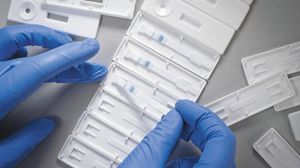
- Laboratory
- Laboratory medicine
- Rapid infectious disease test
- Ahlstrom-Munksjö
Rapid lateral flow test CytoSep®for infectious diseasespregnancyfor environmental analysis
Add to favorites
Compare this product
fo_shop_gate_exact_title
Characteristics
- Applications
- for infectious diseases
- Application field
- pregnancy, for environmental analysis, veterinary, for abused drugs, for food safety
- Tested parameter
- for antigens
- Sample type
- plasma, whole blood
- Analysis mode
- lateral flow
Description
Consistent and rapid lateral separation of whole blood
Available in different thicknesses to accommodate range of whole blood sample volumes
Faster blood absorption in HV and HV Plus yields higher volumes of plasma
Customized sheet, rolls and specialty die cut sizes
CytoSep® single layer plasma separation media consisting of high purity natural and synthetic fibers for whole blood diagnosis
Ahlstrom CytoSep® is widely used for rapid separation of plasma from whole blood samples in lateral flow applications, retaining blood cells while allowing serum to flow rapidly.
There are three established grades which differ in thickness: CytoSep® 1660, CytoSep® 1662, CytoSep® 1663. These grades are able to load from low to high volumes of blood.
The newest CytoSep® products, 1667 HV and 1668 HV Plus, are designed to separate increased volumes of whole blood within the same area of media while limiting hemolysis. This new generation of CytoSep® was developed as a thin material like 1660, thus allowing higher plasma area recovered and requiring less chasing buffer. This grade is preferable when you want to achieve better sensitivity.
CytoSep® HV Plus 1668 combines both chemical and mechanical filtration processes for higher performance and increased options for product development. The chemicals help to deform shape of red blood cells and so limit their diffusion while the specific pore size blocks the residual mobile red blood cells.
Catalogs
Related Searches
- Assay kit
- Molecular biology reagent kit
- Infectious disease detection kit
- Blood rapid diagnostic test
- Rapid lateral flow test
- Laboratory reagent kit
- Plasma rapid diagnostic test
- Infectious disease rapid diagnostic test
- Whole blood rapid diagnostic test
- Reagent medium reagent kit
- Lateral flow test kit
- Test strip
- Strip rapid diagnostic test
- Animal assay kit
- DNA extraction reagent kit
- Hormone test kit
- Rapid drug abuse test
- Obstetrical/gynecological rapid test
- RNA extraction reagent kit
- PH reagent kit
*Prices are pre-tax. They exclude delivery charges and customs duties and do not include additional charges for installation or activation options. Prices are indicative only and may vary by country, with changes to the cost of raw materials and exchange rates.







